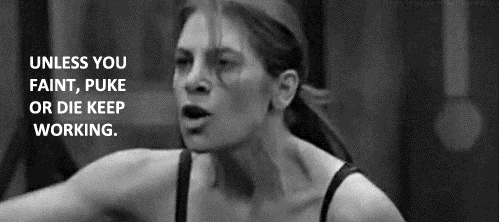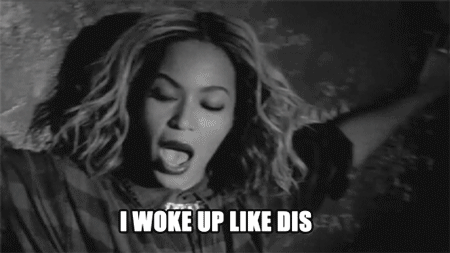“Dear Pre-collegiette,
Congratulations! On behalf of Awesome University…”
Phew! You can breathe a sigh of relief, because you’re in. Now that you’ve gotten that acceptance letter, your future is safe, and you can finally take a break from school for the first time in 14 years. Bring on the Nutella and Friends marathons. #blessed
Not so fast. We hate to break it to you, pre-collegiettes, but after a little celebratory R&R, you need to get off the couch and back to your desk. Even though you’ve already secured a spot in college, your school can still take back your acceptance if you start slacking.
Here’s the truth about rescinded college acceptances and how you can fight senioritis to make sure your acceptance letter isn’t followed by a warning one.
Having your admission revoked
![]()
Unlike the myth that Greek life is one big toga party or that everyone gains the Freshman 15, having your college acceptance revoked before you even arrive due to poor second-semester grades (or other factors!) can actually happen.
Does this mean if your A in AP Spanish slips to a B that you can say hasta la vista to college? Definitely not. However, if you slip more than one or two full letter grades, that’s when colleges start taking notice.
“If you’re an A student, a D or an F could certainly do it,” says Bev Taylor, founder of The Ivy Coach, a college admissions counseling practice. “If you got some Cs, the college would probably just ask you to explain your grades and see if you had a valid reason for their drop.”
Why is your school allowed to revoke your acceptance? Well, if you look at your acceptance letter, Taylor says you’ll likely notice there’s a clause making your acceptance “conditional upon the successful completion of the final year of high school.” Your letter may have that exact phrasing, or it may say something like, “It is our expectation that you remain fully engaged in your studies and other pursuits for the remainder of your secondary school career.”
According to Taylor, that means you have to maintain the image of yourself that you presented in your application, whether you had a 4.0 or a 2.5.
So if you have minor grade slips? Not an issue.
“If you’re a B student and you have a C or two Cs, the same thing goes [as when A students get Bs],” Taylor says. “[The school] would probably never ask you about it.”
Collegiette Allison* says her C- in BC Calculus did not cause her school to revoke her acceptance.
“I got accepted off the waitlist for an Ivy League school, despite [my math grade],” she says. “Because I had maintained good grades in my other classes, and it had been pretty clear from my application that I was in no way going to end up as a math major, my school let it slide.”
However, it doesn’t matter if you’re an A, B or C student or what field you’re interested in. Taylor says in almost any scenario, an F could cause a school to revoke a student’s acceptance.
It’s not just receiving poor grades that can lead to a revoked acceptance. Dropping a course or switching to a less rigorous one—for example, deciding to move from AP Art History to pottery your second semester—is also considered a violation of the “successful senior year completion” clause, Taylor says. Changing one class most likely won’t end with a college revoking your acceptance; however, if you were to drop all of your AP classes for joke electives, that’s a different story!
“After I got in to my school, I decided I didn’t want to stay in my AP Econ and AP Computer Science courses,” says collegiette Kelsey*. “I transferred to basic classes that still fulfilled my high school’s requirements. Then, my college sent me a letter asking me to explain why I wasn’t taking the same courses [with which] I had started the year.”
Taylor says there are two types of letters you can receive for slacking off. The first, in which the admissions team says it has noted your drop in grades or class changes and would like an explanation, is the most common. The second, in which your acceptance is revoked with no warning, is pretty rare and usually reserved for non-grade-related infractions, like getting caught cheating or being arrested.
How to respond
![]()
If you get a warning letter, it shouldn’t come as a shock that you should take immediate action to bring up your grades. Talk to your teachers, schedule an appointment with your counselor and establish a study and homework plan—basically, do everything in your power to return your GPA to its former state.
Taylor says you should also reply to the college. Maybe something happened in your personal life that makes your grade change a little more understandable, such as a family illness or death. In those cases, explain what happened, apologize for your lapse and say you’re working to improve your grades.
For example, you could write:
Dear Awesome University,
Thank you for your recent letter inquiring into my grades. Those grades are not an accurate reflection of my work ethic, and I apologize. They have slipped due to circumstances I could not have expected or prepared for. In late December, my mother fell ill, and coping with her illness has made it difficult for me to concentrate on my schoolwork. I am doing my best to raise my grades and want to reassure you that I maintain the commitment to excellence that I had when I applied to your school.
Thank you for your understanding,
Pre-collegiette
However, you might not have mitigating circumstances to point to. While “senioritis” isn’t a valid excuse, you should send a letter to your school acknowledging your missteps and promising to rectify the situation.
It might go without saying, but once you’ve told the school you’re working on bringing up your grades, it’s essential that you actually, you know, work to bring up your grades.
How to stay focused
![]()
When it comes to staying focused during your last semester of high school, Taylor recommends keeping your eye on the prize.
“You’ve worked all these years to get into the college of your dreams, and now you’re going to give that all up by stopping before the finish line?” she says. “That makes no sense.”
Remind yourself what you’re (still) working for by printing out a picture of your future campus and pinning it on your bulletin board, wearing your college colors to school or setting your college’s fight song as your ringtone. Seriously, nothing is too corny if it motivates you.
Jaya Powell, a senior at Duke University, recommends trying to stay interested in your courses so you don’t feel like you’re doing busywork.
“I loved reading, so my senior year I took an AP lit class,” she says. “Because I was so interested in the course material, I had no trouble keeping up with my grades.”
You may also want to ask yourself why you’ve worked for good grades in the first place. Was it really just to get into college, or was it because you care about learning and making yourself proud?
“One thing that keeps me going is constantly asking myself, ‘What do you live for? Why do you care?’” pre-collegiette Angela Phung says. “It's a good reminder that my ultimate goal isn't college; it's to get to college to improve and grow more.”
You can also use your membership in honors clubs to keep your focus up. If membership is based on GPA, letting your grades drop means you might not be able to get that special cord or walk with the other students in honors club on graduation day.
“I'm a second-semester senior that has worked so hard over the past four years, and no matter how much I want to, I'm to going to throw all of that away to go to a few more parties and watch a little more Netflix,” says pre-collegiette Nina Brown. “There's only five more months, and it's not worth it to end my last semester of high school with bad grades.”
![]()
While it’s hard to keep chugging along after you know you have a twin XL bed ready and waiting for you on your future college campus, keep your motivation going strong by remembering that that twin XL isn’t quite yours yet. If you keep your grades up, you’ll have no reason to fear that letter asking you to explain or worse, gulp, saying your acceptance has been rescinded.
So finish strong, pre-collegiettes! You’ll be collegiettes soon.
*Names have been changed.




 A toned-down version of Lady Gaga’s infamous hair bow, this cute hairstyle is great for everyday wear. Grab small sections of hair from both sides. Cross the sections at the back. Tie hair into a bow and secture with bobby pins. Wear the rest of your hair straight, wavy or curled. Mini bobby pins from Conair ($1.89) will help secure your look.
A toned-down version of Lady Gaga’s infamous hair bow, this cute hairstyle is great for everyday wear. Grab small sections of hair from both sides. Cross the sections at the back. Tie hair into a bow and secture with bobby pins. Wear the rest of your hair straight, wavy or curled. Mini bobby pins from Conair ($1.89) will help secure your look.







































 Reality
Reality Expectation
Expectation Reality
Reality Expectation
Expectation Reality
Reality Expectation
Expectation Reality
Reality Expectation
Expectation Reality
Reality Expectation
Expectation Reality
Reality Expectation
Expectation Reality
Reality Expectation
Expectation Reality
Reality Expectation
Expectation Reality
Reality





































